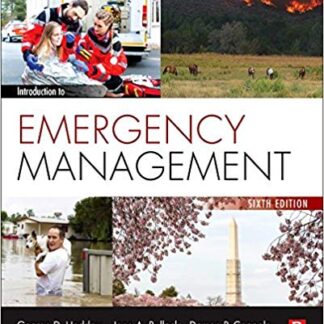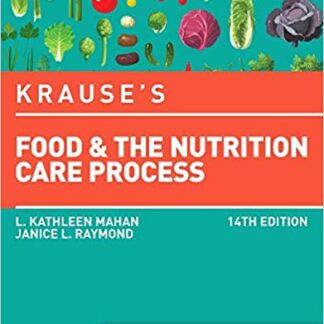Description
HVAC Systems Design Handbook 4th Edition, ISBN-13: 978-0071395861
[PDF eBook eTextbook] – Available Instantly
Publisher: McGraw-Hill Professional; 4th edition (February 28, 2003)
Language: English
513 pages
ISBN-10: 0071395865
ISBN-13: 978-0071395861
UPDATED TO REFLECT THE LATEST CODES AND SPECIFICATIONS
ONE-STOP GUIDANCE ON DESIGNING EFFICIENT AND EFFECTIVE RESIDENTIAL, COMMERCIAL, AND INDUSTRIAL HVAC SYTEMS
Here’s an all-in-one working tool for every phase of the HVAC design process – packed with a treasury of applications and invaluable on-the-job insights that reflect the author’s half-century in the HVAC field.
Featuring today’s only truly integrated approach to the subject, the Handbook offers thorough coverage of the latest technological and procedural advances in the design and installation of HVAC systems. The Fourth Edition offers completely updated code references, new coverage of energy conservation and digital control practice, and a greater focus on indoor air quality, including maintenance and operation.
Enhanced by more than 300 job-simplifying illustrations and tables, the Handbook provides HVAC design pros with everything they need to design, operate, and maintain peak-performing HVAC systems.
Table of Contents:
Contents
Preface
Acknowledgments
Introduction
Chapter 1. HVAC Engineering Fundamentals: Part 1
1.1 Introduction
1.2 Problem Solving
1.3 Value Engineering
1.4 Codes and Regulations
1.5 Fluid Mechanics
1.6 Thermodynamics
1.7 Heat Transfer
1.8 Psychrometrics
1.9 Sound and Vibration
1.10 Energy Conservation
1.11 Summary
References
Chapter 2. HVAC Engineering Fundamentals: Part 2
2.1 Introduction
2.2 Comfort
2.3 Use of Psychrometrics
2.4 HVAC Cycles
2.5 Control Strategies
2.6 Architectural, Structural, and Electrical Considerations
2.7 Conceptual Design
2.8 Environmental Criteria for Typical Buildings
2.9 Designing for Operation and Maintenance
2.10 Summary
References
Chapter 3. Design Procedures: Part 1—Load Calculations
3.1 Introduction
3.2 Use of Computers
3.3 Rule-of-Thumb Calculations
3.4 Design Criteria
3.5 Factors for Load Components
3.6 Load Calculations
3.7 Dynamic versus Static Load Calculations
3.8 Ventilation Loads
3.9 Other Loads
3.10 Summary
References
Chapter 4. Design Procedures: Part 2—General Concepts for Equipment Selection
4.1 Introduction
4.2 Criteria for System and Equipment Selection
4.3 Options in System and Equipment Selection
4.4 The Psychrometric Chart
4.5 Effects of Altitude and Temperature
4.6 Use of Computers
4.7 Summary
References
Chapter 5. Design Procedures: Part 3—Air-Handling Systems
5.1 Introduction
5.2 Fans
5.3 Air Duct Design
5.4 Diffusers, Grilles, and Registers
5.5 Louvers
5.6 Dampers
5.7 Filters
5.8 Air Distribution with High Flow Rates
5.9 Stratification
5.10 Noise Control
5.11 Indoor Air Quality
5.12 Summary
References
Chapter 6. Design Procedures: Part 4—Fluid-Handling Systems
6.1 Introduction
6.2 Steam
6.3 Water
6.4 High-Temperature Water
6.5 Secondary Coolants (Brines and Glycols)
6.6 Piping Systems
6.7 Pumps
6.8 Refrigerant Distribution
6.9 Summary
References
Chapter 7. Design Procedures: Part 5—Central Plants
7.1 Introduction
7.2 General Plant Design Concepts
7.3 Central Steam Plants
7.4 Central Hot Water Plants
7.5 High-Temperature Hot Water Plants
7.6 Fuel Options and Alternative Fuels
7.7 Chilled Water Plants
7.8 Thermal Storage Systems
7.9 Heat Recovery Plants
7.10 Central Plant Distribution Arrangements
7.11 Cogeneration Plants
7.12 Summary
References
Chapter 8. Design Procedures: Part 6—Automatic Controls
8.1 Introduction
8.2 Controls Fundamentals
8.3 Control Devices
8.4 Instrumentation
8.5 Typical Control Systems
8.6 Electrical Interfaces
8.7 Computer-Based Controls
8.8 Control Symbols
8.9 Summary
References
Chapter 9. Equipment: Part 1—Cooling
9.1 Introduction
9.2 Refrigeration Cycles
9.3 Compressors
9.4 Chillers
9.5 Condensers
9.6 Cooling Towers
9.7 Cooling Coils
9.8 Radiant Cooling
9.9 Evaporative Cooling
9.10 Refrigerants
9.11 Summary
References
Chapter 10. Equipment: Part 2—Heating
10.1 Introduction
10.2 General
10.3 Boiler Applications
10.4 Boiler Types
10.5 Combustion Processes and Fuels
10.6 Fuel-Burning Equipment
10.7 Boiler Feedwater and Water Treatment Systems
10.8 Boiler Codes and Standards
10.9 Boiler Design
10.10 Acceptance and Operational Testing
10.11 Direct- and Indirect-Fired Heating Equipment
10.12 Heat Exchangers—Water Heating
10.13 Heat Exchangers—Air Heating
10.14 Unit Heaters and Duct Heaters
10.15 Terminal Heating Equipment
10.16 Heat Pumps
10.17 Heat Recovery and Reclaim
10.18 Solar Heating
10.19 Humidification
10.20 Summary
References
Chapter 11. Equipment: Part 3—Air-Handling Systems
11.1 Introduction
11.2 AHU System Arrangements
11.3 Package Air-Handling Units
11.4 Built-Up (Field-Assembled) AHU
11.5 Terminal Units
11.6 Individual Room AHUs
11.7 Humidity Control
11.8 Control of Outside Air Quantity
11.9 Effects of Altitude
11.10 Exhaust Systems
11.11 Smoke Control
11.12 Summary
References
Chapter 12. Electrical Features of HVAC Systems
12.1 Introduction
12.2 Fundamentals of Electrical Power
12.3 Common Service Voltages
12.4 Power Factor
12.5 Motors
12.6 Variable-Speed Drives
12.7 HVAC–Electrical Interface
12.8 Uninterruptible Power Supply
12.9 Standby Power Generation
12.10 Electrical Room Ventilation
12.11 Lighting Systems
12.12 National Electric Code
12.13 Summary
References
Chapter 13. Design Documentation: Drawings and Specifications
13.1 Introduction
13.2 The Nature of Contracts
13.3 Drawings
13.4 Specifications
13.5 Summary
References
Chapter 14. After Design: Through Construction to Operation
14.1 Introduction
14.2 Participation during Construction
14.3 Commissioning
14.4 Summary
References
Chapter 15. Technical Report Writing
15.1 Introduction
15.2 Organization of a Report
15.3 Writing with Clarity
15.4 Use of Tables and Figures
15.5 Printing and Binding
15.6 Letter Reports
15.7 Summary
Reference
Chapter 16. Engineering Fundamentals: Part 1—Fluid Mechanics
16.1 Introduction
16.2 Terms in Fluid Mechanics
16.3 Law of Conservation of Mass
16.4 The Bernoulli Equation (Law of Conservation of Energy)
16.5 Flow Volume Measurement
16.6 Summary
References
Chapter 17. Engineering Fundamentals: Part 2—Thermodynamics
17.1 Introduction
17.2 Thermodynamics Terms
17.3 First Law of Thermodynamics
17.4 Second Law of Thermodynamics
17.5 Efficiency
17.6 Coefficient of Performance
17.7 Specific Heat C[sub(p)]
17.8 Summary
References
Chapter 18. Engineering Fundamentals: Part 3—Heat Transfer
18.1 Introduction
18.2 Heat Transfer Modes
18.3 Thermal Conduction
18.4 Thermal Convection
18.5 Thermal Radiation
18.6 Latent Heat and Moisture
18.7 Summary
References
Chapter 19. Engineering Fundamentals: Part 4—Psychrometrics
19.1 Introduction
19.2 Thermodynamic Properties of Moist Air
19.3 Tables of Properties
19.4 Psychrometric Charts
19.5 HVAC Processes on the Psychrometric Chart
19.6 The Protractor on the ASHRAE Psychrometric Chart
19.7 Effects of Altitude
19.8 Summary
References
Chapter 20. Engineering Fundamentals: Part 5—Sound and Vibration
20.1 Introduction
20.2 Definitions
20.3 Methods of Specifying and Measuring Sound
20.4 Sound and Vibration Transmission
20.5 Ambient Sound-Level Design Goals
20.6 Reducing Sound and Vibration Transmission
20.7 Summary
References
Chapter 21. Indoor Air Quality
21.1 Background
21.2 Negative Effects of Poor Air Quality
21.3 Positive Effects of Air Quality
21.4 Sources of Poor Air Quality
21.5 Attaining Good IAQ: Responsibilities of the Designer
References
Index
Roger W. Haines, P.E. is widely recognized as one of the foremost authorities in the field of HVAC Engineering. He is the author of Roger Haines on HVAC Controls and is a frequent contributor to HPAC Engineering Magazine. Mr. Haines resides in Laguna Woods,California.
C. Lewis Wilson, P.E. is Chairman and CEO of the Heath Engineering Company and former Professor of HVAC at the University of Utah, Brigham Young University, and the University of New Mexico. Mr. Lewis is a resident of Salt Lake City, Utah.
What makes us different?
• Instant Download
• Always Competitive Pricing
• 100% Privacy
• FREE Sample Available
• 24-7 LIVE Customer Support




